Please use the following link to download the May 21, 2022 issue of the syəcəb
Following the Salmon Ceremony Part 5: The Songs of the Ceremony
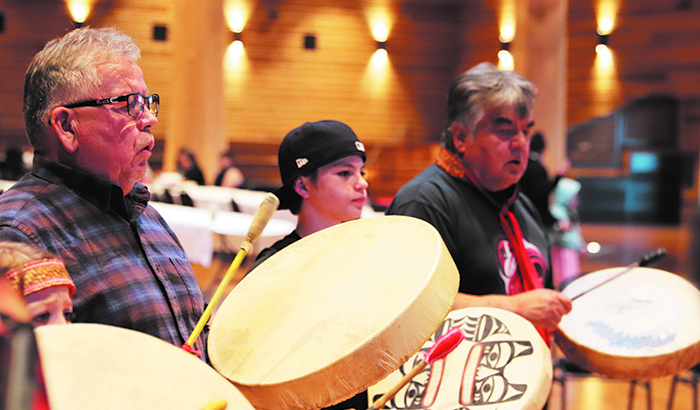
By Kalvin Valdillez, Tulalip News
“The elders taught us that we always need to be listening because some day you’ll be tapped on the shoulder to say something, to take over or lead something, and you need to be prepared,” said Tulalip tribal member, Glen Gobin. “Back in 1968, before the revival, they wanted the youth, which at the time included myself and my siblings, to start to learn some of the songs that we still use as part of the Salmon Ceremony today – the welcome song, the happy song. We were taught those songs at early age and I always felt honored to be a part of that.”
With less than a month to go, the tribal community of Tulalip continues to prepare for their annual Salmon Ceremony gathering, which will be held this year on Saturday June 11, beginning at 10:30 a.m. at the Tulalip Longhouse. Over the past four weeks, dancers, drummers and speakers have been getting reacquainted with their traditional songs by participating in weekly practice sessions, starting at 5:00 p.m., every Thursday.
The practices have been hosted at the Tulalip Gathering Hall, however, the final practice on June 9th will be held at the longhouse. During the approximate two-hour practice session, the tribe takes time to walkthrough the entire Salmon Ceremony from top to bottom, so the people can really get an understanding about what the songs and dances mean to the tribe, and why they are offered each year.
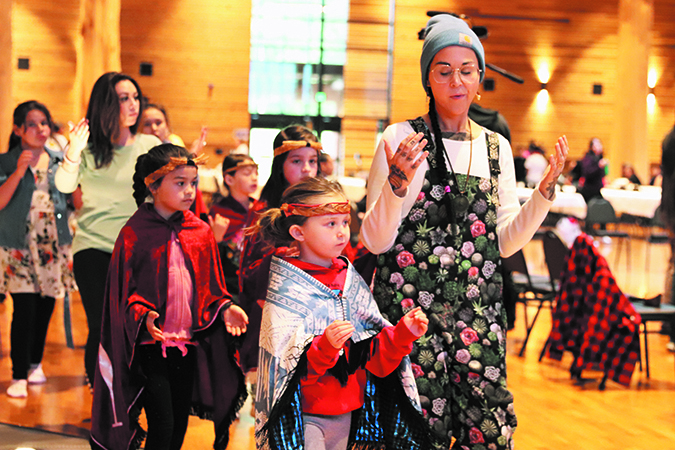
“I love being at the center of the longhouse when we’re all in there together and we all sing [The Prayer Song] for the first time,” Glen expressed. “The power of song with all our voices is very moving, you can feel it inside you. I try to get the kids to feel that – the power of our voices. It gives you strength and encouragement and it also makes you feel that you belong, that you fit in.”
Revived back in the mid-70’s, the Salmon Ceremony has become a staple tradition at the start of each fishing season for the people of Tulalip. During the ceremony, the tribe welcomes and honors the first king salmon to arrive at local waters. The ceremony also serves as a way to provide the fishermen of the tribe with a blessing before they hit the Salish Sea to harvest salmon for their people.
Prior to the assimilation era, the Salmon Ceremony was practiced by the Snohomish people since time immemorial. The ceremony was brought back in an historic effort by Harriette Shelton Dover and a handful of elders who were able to recall the songs and dances that were performed at the event. Those songs and dances were then passed on to the next generation. And ever since, the tribe has passed down the teachings year by year to the future of Tulalip.
Many Salmon Ceremony participants will be the first to tell that the practices leading up to the actual ceremony are equally important as the special day of honoring itself. Tribal leaders are welcoming the entire community out to the remaining practices, four in-total before the big day.
In 2020, for the first time since the revival, the Salmon Ceremony and all the practices were canceled due to the pandemic. In 2021, the tribe brought the ceremony back, but in an effort to limit the spread of COVID, there were no practices leading to the event. These important practices, where traditions are handed down to the next generations, were canceled for two straight years in a row, and the participants felt as if a significant piece to the ceremony was left out. Now with the return of the practices, the people feel a stronger connection to the songs, dances and stories that will be shared at the ceremony.
Said Glen, “It’s about giving respect to those that come from nature. But it also teaches about giving respect throughout life and honoring those gifts that we get and respecting our way of life in a good way. Part of that is making sure how we sing the songs, how we conduct ourselves, it teaches how to carry yourself in life. All of the songs have meaning, everything is connected. The songs encourage the people to carry themselves in a good way.”
In anticipation of the Salmon Ceremony, Tulalip News has been featuring a weekly mini-series focused on the all the important work that goes into the annual event. Over the past four weeks, we took a deeper look into the ceremony, highlighting its history and stories. This week, we sat down with Glen, the official Salmon Ceremony Leader, a title handed down from the late Stan ‘Scho-Hallem’ Jones and Bernie ‘Kai Kai’ Gobin, to go over the eleven songs, blessing and chants that are offered at the ceremony each and every year.
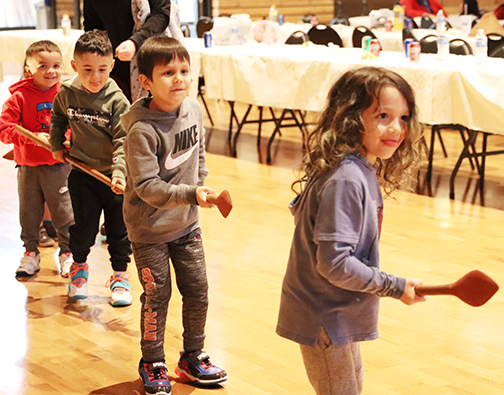
The Welcome Song
Glen: “The Welcome Song is well-known and it is Harriette Shelton Dover’s song. For a long time, when we sang her song, Harriette was the only one in front of everyone, with the strongest drummers and singers following behind her. Now we have four elders leading us, typically two times around the longhouse, to start the ceremony.”
Sduhubš War Song
“This is where all our young warriors line up with their spears. A while ago, I was back at D.C. at the National Archives building. In some of the writings there is a record of this song, the sduhubš war song. And it tells what the meaning is: I am Sduhubš, I am a fierce warrior. I have nothing but friends, for I have already killed all our enemies.”
Eagle/Owl Song (Tribute to Kai Kai)
“You know, Stan always called it the Eagle/Owl song, but nowhere in the song do we sing about the eagle. But anyway, it’s a Jones family song and he gave it to the ceremony. Scho-Hallem gathered Kai Kai, because they grew strength from each other and prayed for each other. Kai Kai was my father, him and Scho-Hallem were very close friends. They were very strong leaders for our tribe. They worked together as a team for our tribe to help us move forward to where we are today.”
Blessing Song
“The blessing of the fishermen! This was a song that was gifted to Stan and my dad by a lady named Bev Tom. It is about remembering your ancestors and remembering where you come from. It’s a blessing of the fishermen to wish them good luck and a safe season.”
Listen to our Prayers
“I love being at the center of the longhouse when we’re all in there together and we all sing this for the first time. The power of song with all our voices is very moving, you can feel it inside you.”
hikw siyab yubəč
“This song is one of the primary Salmon Ceremony songs. These are all prayer songs. We sing this all the way down to the beach, once yubəč is here. We sing this to greet our visitor. Once the canoe has landed, and he’s unloaded, he now leads the way. From this point for the rest of the ceremony, he’s at the front, nobody goes in front of him. We sing this all the way to the longhouse and then again when we take him back to the water. We recognize him, give thanks. He is the scout, he comes to see how well we are doing and if we treat him correctly, he’ll tell his people that the Tulalip’s are good people.”
Happy Song
“This is a crowd favorite where the Shawl Dance is performed. Back in 1968, before the revival, they wanted the youth, which at the time included myself and my siblings, to start to learn some of the songs that we still use as part of the Salmon Ceremony today – the welcome song, the happy song.
We were taught those songs at early age and I always felt honored to be a part of that. All of the songs have meaning, everything is connected. The songs encourage the people to carry themselves in a good way. And that goes back to the sduhubš people, we were always considered high class. But not high class like I’m better than you. Others viewed our people as siyab, high class people, because the way we carried our people.”
Table Blessing Song
“The table blessing song is thousands of years old, it’s been around that long and that’s how it was shared with us. It’s a very powerful song. It’s not often that you have a prayer song that has that fast of a beat, that you sing it that loud. Maybe it’s a joyous prayer. We all take a small piece of fish and eat the guest at the same time. Then we all take a drink of a half-glass of water together at the same time.”
Canoe Song (Kenny Moses Jr.’s Song) & New Beginnings Cleansing Song (Glen’s Song)
“Through the years we added some songs at the end. It used to end to stop at hikw siyab yubəč, but then the canoes still had to paddle out. That’s when Kenny’s song came. We started singing Kenny’s song for the canoe returning to the shore once more.
But then the girls wanted another song that they could dance to, because they didn’t want to leave, so I shared my song at the end. It’s a song of cleansing and new beginnings. It’s about, as you walk through life, you gather up all these things and you hang on to them. At different times you need to start to release them, because either some of those things start to bother you or you no longer need them so you release those things and only keeps what gives you strength and keeps you going. So you’re starting over again, that new beginning and you’re cleansing by releasing what doesn’t serve you.
When that song came to me, it was weird because I never thought I would receive a song. We were doing some spiritual work, canoes were put away for a year, we brought them back out and brushed them off and put them in the water. We were coming back by the longhouse and I was coming up the hill and the song started coming to me like a ton of bricks. I got home and sang it for about two hours. I drove around all week, singing it all the time. It wouldn’t leave. So finally I called Kenny Moses Jr. He came up to my dad’s house and I sang it there. He asked me about what I was thinking of and feeling at the time. It’s kind of a cleansing song about new beginnings.”
It’s for the kids! 24th Annual B&GC Auction raises over $560,000
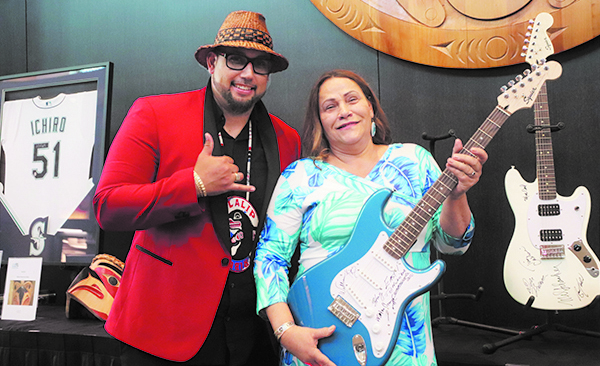
By Micheal Rios, Tulalip News
During the evening of Saturday, May 14, the Tulalip Resort Casino’s orca ballroom was home to the 24th Annual Tulalip Boys and Girls Club Auction. The signature fundraising event of the season was all about giving gracious donors and committed community members an opportunity to paint a brighter future for Tulalip kids.
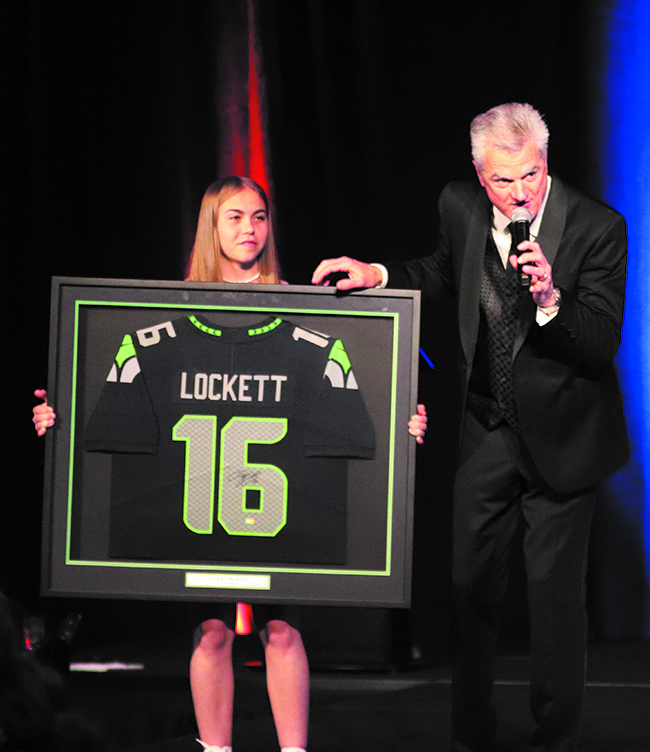
“As a former club kid, I personally know the positive impacts of having a Boys & Girls Club in my community,” shared auction chairwoman Belinda Hegnes. She also serves her tribe as executive vice president of Quil Ceda Creek Casino. “The club was a safe place to meet friends, hang out after school and during the summer. As a child, there was always something fun to do. One of my earliest memories was learning to shoot a basketball by then club director, Terry Freeman.
“We wanted this year’s auction theme to send a positive message to our youth that even when times are tough to keep moving forward and focus on the future,” she continued. “This past year the pandemic continued to impact our communities and our youth. We all at some point experienced a little fear, uncertainty, social restrictions and isolation from loved ones. Tonight, we finally get to come together to paint a bright future and make a positive impact for the children!”
‘The Club’, as it’s affectionately been dubbed by the hundreds of children who attend daily, is a safe place where kids can just be kids. While there, children are routinely exposed to healthy food choices, learn many useful skills, create an abundance of happy memories, and make relationships that last a lifetime.
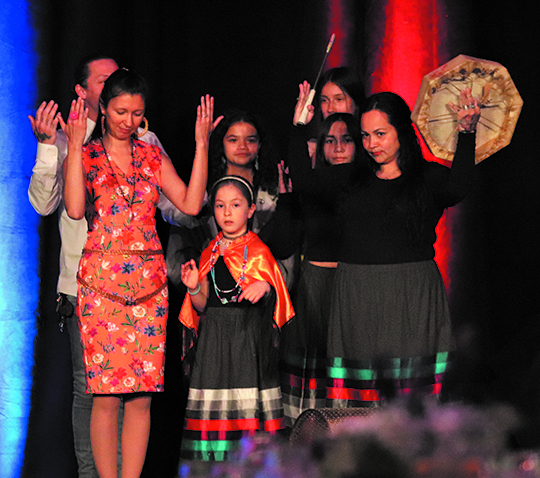
The Club is the first of its kind to be built on tribal land in Washington. Established over twenty-five years ago, 2022 marks nearly three decades worth of commitment to the community. Through before and after school programs, our local club aims to help young people improve their lives by building self-esteem, developing core values, and teaching critical skills during opportune periods of growth.
“What an amazing evening to be together with all of you for our signature event that supports the Tulalip Boys and Girls Club,” said Tulalip Chairwoman Teri Gobin. “The funds raised from this one event truly makes a huge impact on the lives of so many of our kids. We have so many leaders who grew up as club kids and now are professionals working in management positions at both our casinos, Quil Ceda Village, and in many departments of our tribal government. That’s a significant impact the boys and girls clubs has had on our people, and that’s the impact we are all here to support.”
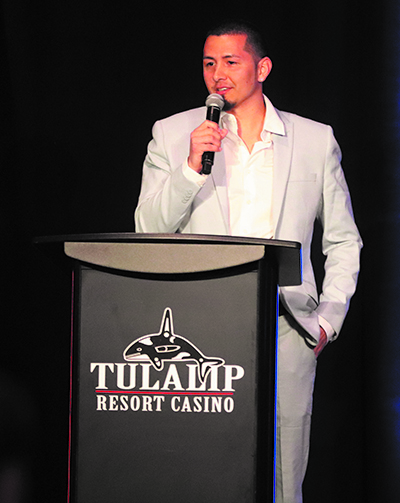
Serving as a model for those working to improve the lives of young people in the surrounding communities, the Club is the primary beneficiary of the annual fundraising auction. With each auction building off the success of the previous years, the Club has not only been able to sustain services, but to complete much needed campus expansions that add additional learning and activity space.
Funds raised from the annual actions are dedicated for capital improvement, not operating costs. Previous auction funds have paid for a state-of-the-art music studio, a multi-media room with twenty-plus computers, several transportation vehicles, roof repairs, upgraded kitchen equipment, and even a 4,000-square-foot technology-filled extension to better accommodate an ever-growing teenaged membership. This teen center was invaluable over the past two years. In such a tumultuous time, local teenagers were able to depend on access to this tech-driven space to meet their computer access and internet needs to complete schoolwork.
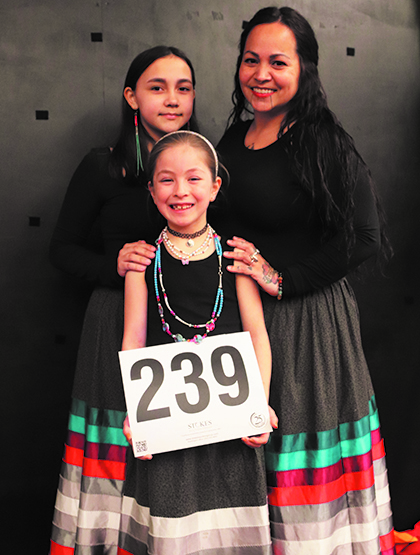
matching ribbon skirts, were excited to bid on a number of silent auction items.
“It’s so funny looking back because I didn’t realize how much the Club meant to me as a kid, but really it was everything,” shared Club Director, Shawn Sanchey. The 26-year-old Tulalip tribal member has come full circle after he himself grew up a Club kid and now manages the same facility so many kids depend on every day. “It’s amazing being able to witness these kids learn and grow in the same way staff once did for me. It really is unique how dedicated our staff are to the youth in our community.
“Thanks to our generous supporters we are able to alleviate costs associated with team and individual sports, which anyone who knows anything about Tulalip can tell you, we have a ton of aspiring athletes,” he added. “Some highlights from the past year are having 150 kids play tackle football, 70 kids playing select level basketball, and we started an exciting golf academy that already has 25 kids actively participating. Our dedication to give our kids access to high level sports goes hand-in-hand with our mission to let our kids know we care about them and we care about their future.”
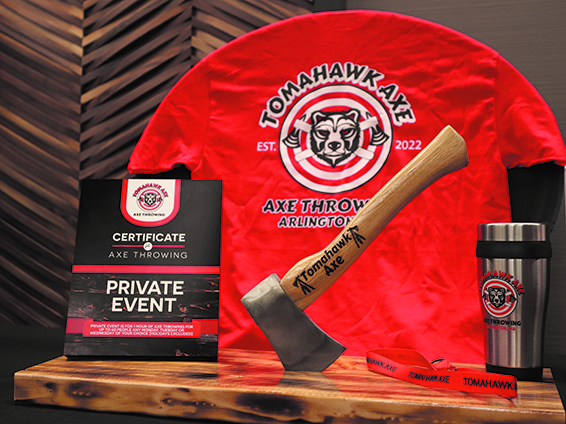
In total, there were over 600 generous individuals in attendance at this year’s 24th annual auction. Many of the attendees have never been inside Tulalip’s reservation-homed boys and girls club. However, the uplifting faces of Club kids were ever-present on actual table centerpieces and projected onto screens bordering the ballroom. There were also a number of Club teenagers who volunteered at the auction and helped generate support by sharing their stories.
One such teenager was 17-year-old Kenzie Thompson-Sheldon who, during the live auction segment, strutted on the main stage with an autographed Tyler Lockett jersey. When auctioneer Mark Schenfeld asked her how much she thinks the Seahawks wide receiver jersey should go for, Kenzie said nonchalantly “Five-thousand dollars.” And $5,000 it went for.
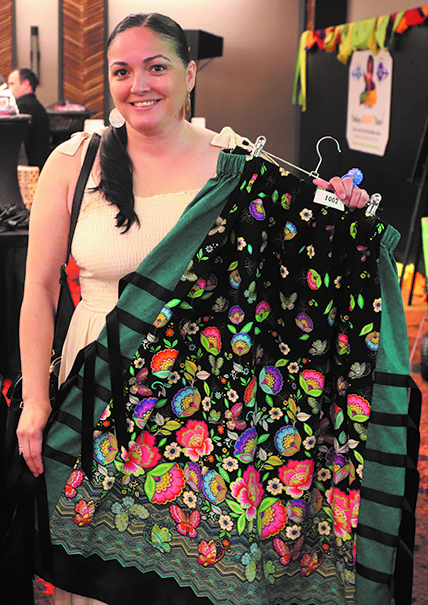
With such an amazing turnout to support the kids came some delightful fundraising numbers. A record $104,200 was raised exclusively for Kids Kafé, which is an essential part of the Club’s services. Kids Kafé addresses the very basic fact that often the meals provided to club members are the most nutritious part of their daily diet. This year, our club transformed into a virtual school site and during this time provided breakfast, mid-morning snack, lunch and afternoon snack. Over the course of the last year, Kids Kafé served an astounding average of 1,280 meals a day.
When the 24th annual action finally came to an end, a whopping $563,646 was raised between the silent and live auctions, including the enormous amount of support for Kids Kafé. There are so many generous contributors who played a critical role in making the 2022 auction one for the history books.
“The auction is really about building relationships with the community and continuing to build upon the strong foundation of support we have with the Tulalip Tribes, Snohomish County, the school board, and the Tulalip Resort Casino,” explained Terry Freeman, Assistant Director of Development for the Boys & Girls Clubs of Snohomish County. “For twenty plus years now, our goal has remained the same – to create more and more partnerships off the reservation to achieve our goals on reservation. Thanks to our tribal leadership team, we continue to meet and exceed this goal.”
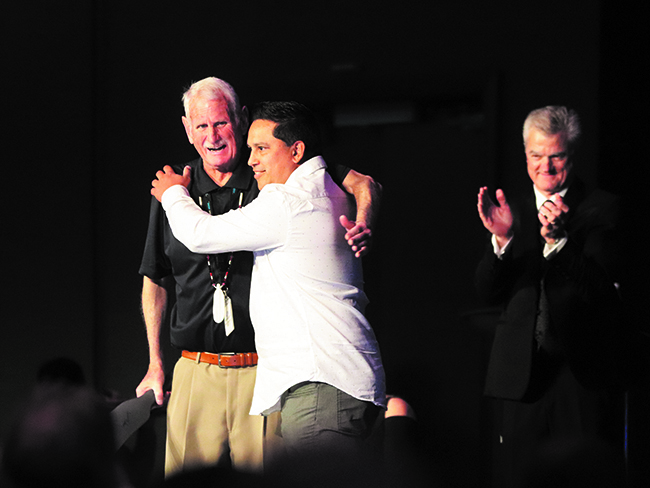
him a paddle and many kind words.
In an emotional moment shared by all that know him, Terry was honored by artist James Madison with a hand-carved, WSU inspired paddle. Terry has dedicated more than 50 years of his life working on behalf of the Boys and Girls Club, where he’s impacted the lives of countless Tulalip tribal members. His limitless energy and enthusiasm for making the lives of today’s youth better is downright contagious, which is why he’s been the perfect behind-the-scenes organizer of twenty-four straight auctions.
“I’ve known Terry since I was just 8-years-old and he ran the Everett Boys and Girls Club. He’s always been a stand-up guy and looked out for us Tulalips, making sure we had what we needed to thrive,” said James. “Now, as an adult, I’m fortunate to call Terry a friend. He deserves all the accolades and more for what he’s done for us. It meant so much to make sure he got his due respect and admiration in front of all these people he brings to our land every year to benefit our kids.”
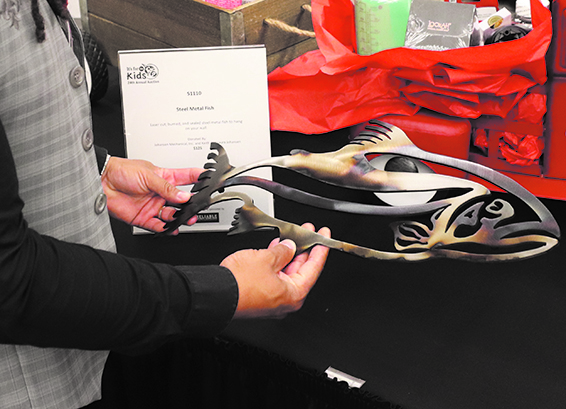
Thanks to everyone who contributed and gave generously, the 24th annual action was a major success. The generosity and heartfelt support received each year from sponsors and volunteers is overwhelming. As in years past, all funds raised will ensure the local Club continues to provide and improve upon quality programs in a fun, safe and positive environment for our kids.
May 14, 2022 syəcəb
Please use the following link to download the May 14, 2022 issue of the syəcəb
John Eaglefeather Enick
May 23, 1977 – May 12, 2022
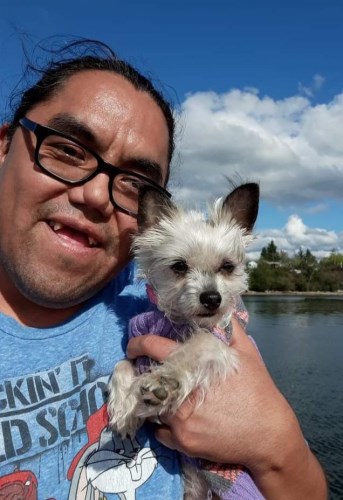
John Eaglefeather Enick(JJ) was born May 23,1977 to G.John Enick Jr and Janice Elaine Bill, he went to be with the lord on May 12th, 2022. He was 44 years old. While he was here he loved to watch wrestling, he was a die hard Seahawks fan, some things he loved was to collect and attend movies, travel to summer and winter Pow wows, barbecues, cook and bake with his loved ones, long drives and walking on the beach with his fur baby, bowling, he loved to joke around and have a good laugh. He worked for TRC as a table games dealer also he was a dishwasher, He leaves behind his mate Jodie Brown, his children fur babie Millie Enick, sons, Dennis Enick/Billy, Nelson Billy, Daughter Tayla Enick/ Billy, sisters Alisa Youcton (Anthony), Karlene Bill (Francis Sr.) Maggie Finkbonner, brothers C. Kurtis Enick, Roman Enick (Teresa), John George IV, Travis Rodriguez, nieces and nephews Sarah,Tela, Mckenze,Tyron & Emma Youcton, Sophelia, Marilyn,Thomas and Francis Williams Jr. Clinton Kurtis Jr., Bobbie Jones, Taleen Enick, Addison Enick & Dylan Enick/ Horne, he was preceded in death by sister Leanne Enick, Nephew Raymeanus Williams, niece Theresa Williams and uncle Michael Enick, first cousin Isaac Bill. He loved all of his nieces and nephews as if they were his own.
A celebration of his life will be held Thursday, May 19, 2022 at 10:00 am at the Tulalip Gathering Hall with burial to follow at Mission Beach Cemetery. Arrangements entrusted to Schaefer-Shipman Funeral Home.
Red dresses raise awareness for MMIWP epidemic
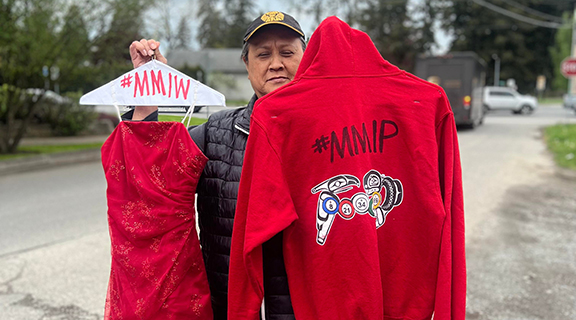
By Kalvin Valdillez; photos by Sarah Jean Hart and Monie Ordonia
Red dresses and shirts hauntingly waved in the wind on MMIWP Awareness Day throughout the reservation of Tulalip. Hanging up on road signs, fences, and even on the Tulalip reader board, the red garments were placed in highly visible areas for local traffic and pedestrians to see, bringing attention to the nationwide epidemic.
“I felt like it was work that had to be done,” said organizer and Tulalip tribal member, Sarah Jean Hart. “I started last year and knew it was something I wanted to do every year. I feel like today, May 5th, is more than just the education piece and the prevention piece, but more so an opportunity to uplift our families and let them know that we’re here for them and that we love them, and to honor the ones who have not come home.”
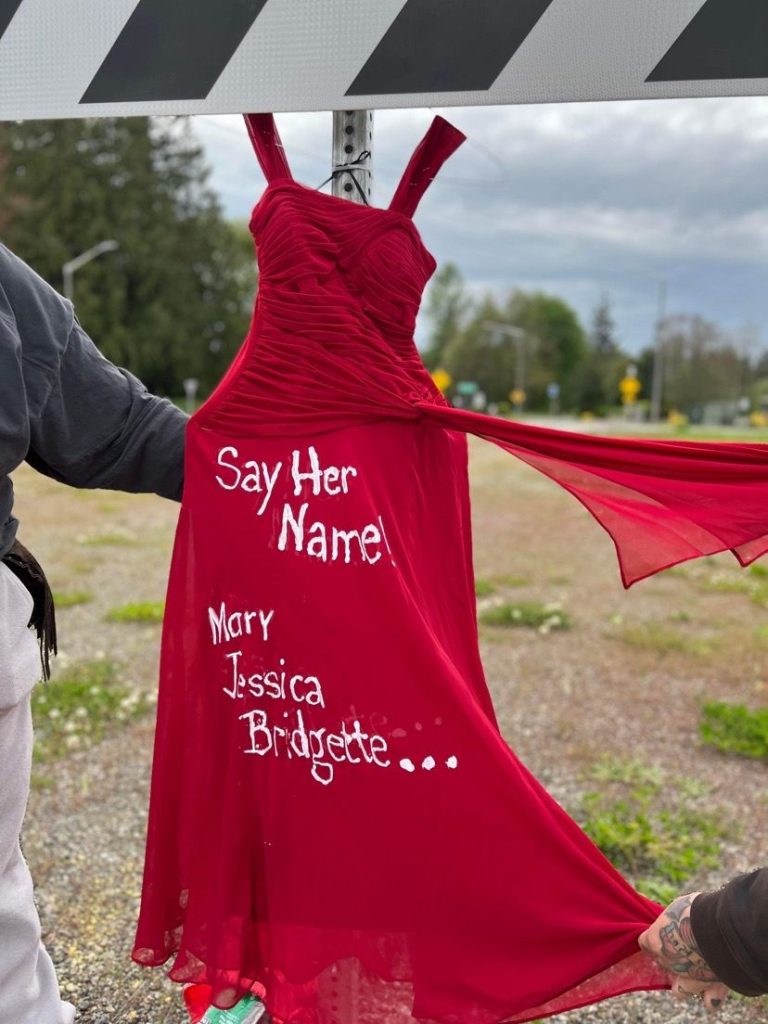
Inspired by a 2010 art exhibit, called the REDress project, red dresses have become a nationally known symbol for the Missing and Murdered Indigenous Women movement. The empty articles of clothing provide a powerful image. The dresses are often displayed in an upright position, giving off the illusion that they are in current use, but the people wearing them appear to be missing.
Since their first art exhibit, the REDress project helped raise awareness about the devastating epidemic over the past decade, while also providing a new and creative way for the Indigenous population to bring attention to the MMIWP movement in their respective tribal communities throughout Canada and the U.S.
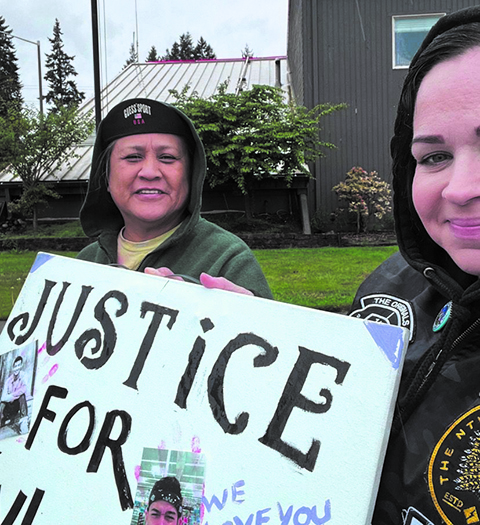
Sarah first brought the project to Tulalip in 2021, and after multiple people approached her and inquired about the dresses, she decided to make this an annual tradition in commemoration of MMIWP Awareness Day. With the help of fellow tribal member, Monie Ordonia, Sarah spent over six hours the day beforehand hanging the dresses and shirts along Marine Drive and in Tulalip neighborhoods.
The red dresses and shirts were accompanied with hand-painted signs that read messages such as: No More Stolen Sisters & Brothers, Rise Up and Protect Our Brothers and Sisters, Remember Them and Say Their Names. A few pieces of clothing also displayed messages – in white paint were the names of those individuals who fell victim to this MMIWP epidemic and called Tulalip home – including Kyle Van Jones, Jr. Lacy, Bridgette Simpson, Jessica Jones and May Ellen Davis.
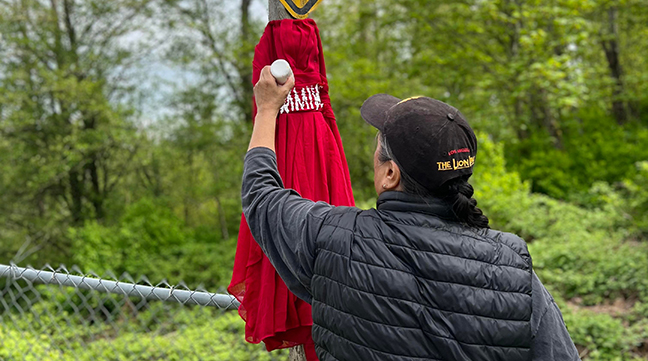
Sarah shared, “A few years ago, it started to really hit home – how many of our own women, not only our women but our brothers too, started going missing. There was no justice for my cousin and so I just knew that we needed to do something. For me to light a candle wherever I put a dress, that’s me letting them know that this is your way home and we’re here waiting for you and we love you.”
In a Facebook post following MMIWP Awareness Day, Sarah also shared, “Our hearts are always in prayer for our MMIW & MMIP. Our loved ones taken too soon. We remember, honor and love you always.”
Following the Salmon Ceremony part 4: MMIWP Candlelight Vigil
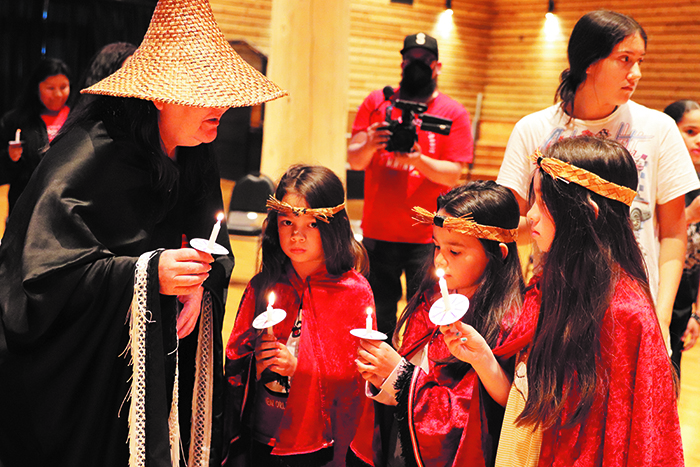
By Kalvin Valdillez, Tulalip News
Another week closer to this year’s Salmon Ceremony, the Tulalip community met once again on Thursday May 5, to practice their traditional songs and dances before the first yubəč, or king salmon, arrives at local waters. The festivities for the honored guest will be held on June 11 this year, beginning at 10:30 a.m., at the Tulalip Longhouse.
The Tulalip Gathering Hall’s acoustics highlighted the fact that the drumbeats were louder and the vocals were stronger this week, as the number of participates continues to grow with each practice. In addition to more drummers and singers, there are notably more shawls and vests on the floor while dancers utilize the entire space of the hall, dancing along to the Tribe’s ancestral songs. Nearly everybody at the third practice session wore red this week, and a couple of people showcased a painted red handprint across their face.
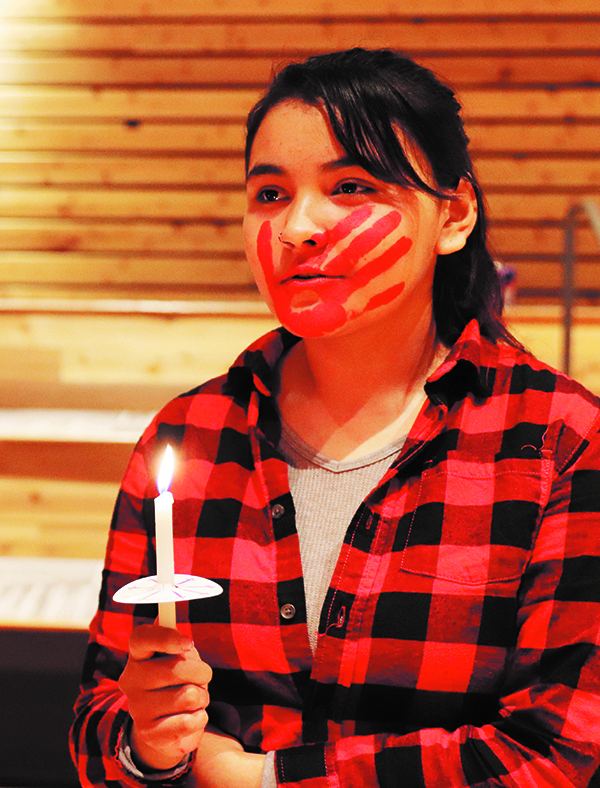
During the weekly gatherings, the people practice an entire walkthrough of the Salmon Ceremony, taking time to explain each song, dance, chant, and blessing. After the revival in 1976, the tribe makes sure to teach the upcoming generation about how Harriette Shelton Dover and a number of Tulalip elders brought the ceremony back following the boarding school era. Almost completely wiped away from existence due to forced assimilation, the Salmon Ceremony is now celebrated at the start of every fishing season.
The ceremony honors the salmon for providing nourishment to the tribal community, while also blessing the local fisherman before they begin harvesting salmon for their families and community this year.
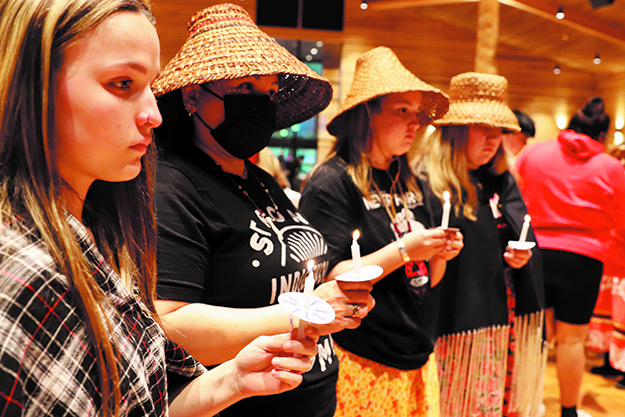
“We honor the gift of our visitor, yubəč, Big Chief King Salmon,” said Tulalip tribal member, Glen Gobin. “We’re harvesting from nature again, it’s how we honor and respect that, to ensure that he’s always going to be there. Him and his people will always be there, returning to take care of our people as they always have.”
As a reminder, Salmon Ceremony practices are held every Thursday at the Tulalip Gathering Hall, beginning at 5:00 p.m. The last practice, on June 9th, will be held at the Tulalip Longhouse. Several tribal leaders, including Chairwoman Teri Gobin, wish to extend a warm welcome to the entire community of Tulalip to the practice sessions to learn about the Salmon Ceremony and all that the traditional event entails, so it can be passed on to the generations of tomorrow.
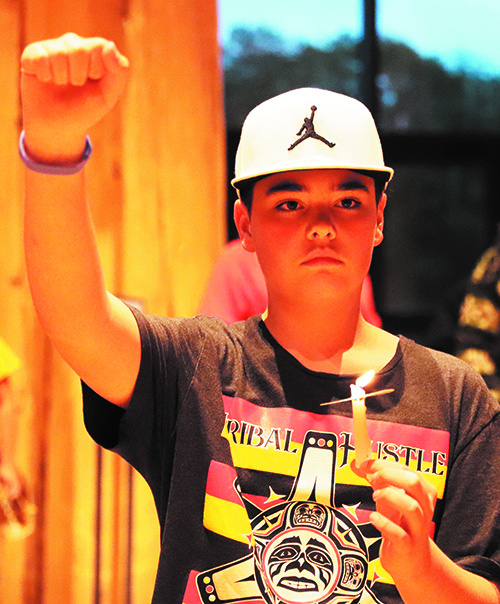
Said Teri, “We’ve come a long way and we’ve been practicing for a lot of years. What is most important now is that we are making sure the young ones are learning the songs, the dances and about those elders who brought it back again.”
Before the last song was performed, Glen explained that this week’s practice was scheduled to end a little bit sooner than usual, while also inviting those in attendance to stay behind for a special candlelight vigil, in remembrance of all the missing Indigenous women and people. The majority of Salmon Ceremony participants did not leave after this week’s practice, but instead spread out from the drum circle in the middle of the floor to seats, also arranged in a circle, placed along the outer edges of the Gathering Hall.
What followed next was a moving tribute held in honor of national MMIWP Awareness Day. Powerful words and heartbreaking stories were shared during the special candlelight vigil and the ceremony provided a safe space for the families of survivors, those individuals missing and those who have passed on, to open up about the national epidemic.
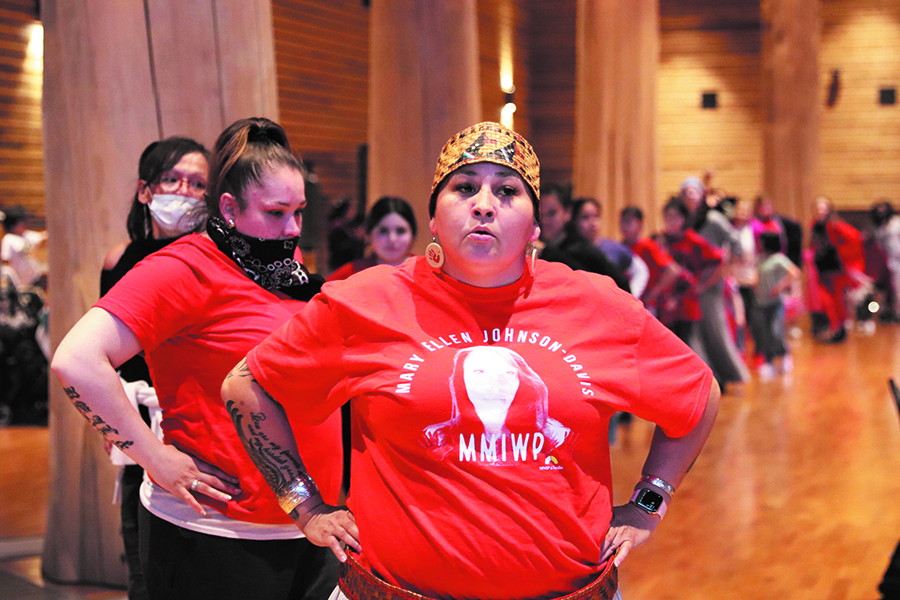
Multiple survivors of domestic violence took the opportunity to warn the young people about the dangers of an abusive relationship, noting that toxic relationships can escalate quickly to unsafe situations. Many of these survivors expressed the difficulty of leaving a dangerous relationship. They also stated that they felt that if they didn’t leave when they did, they might not be here today.
Tribal member, Shawnee Sheldon shared, “Everybody who was in domestic violence, brought awareness tonight. Even though I didn’t speak, I’m a victim of domestic violence. At the age of 17, I was abused by my boyfriend. He isolated me and I was beaten pretty bad. I feared for my life. And at the time, I called my best friend and told her to come and get me and bring me home because I was all the way down in Muckleshoot. She came and got me and I’m forever grateful for her. If she didn’t come for me, I don’t think I would be alive. It sometimes still triggers me. I don’t speak publicly about it, but I can talk individually with people about it, because I know there are people who are put it in the darkness. So just bringing that awareness is huge.”
A number of speakers also urged the youth to be aware of their surroundings at all times, and to reach out for help when it’s needed. Several speakers reiterated to the future generation to be safe and communicative with their families about where they are going, who they are with, and how they are doing because the rate at which Indigenous people go missing continues to climb throughout the nation.
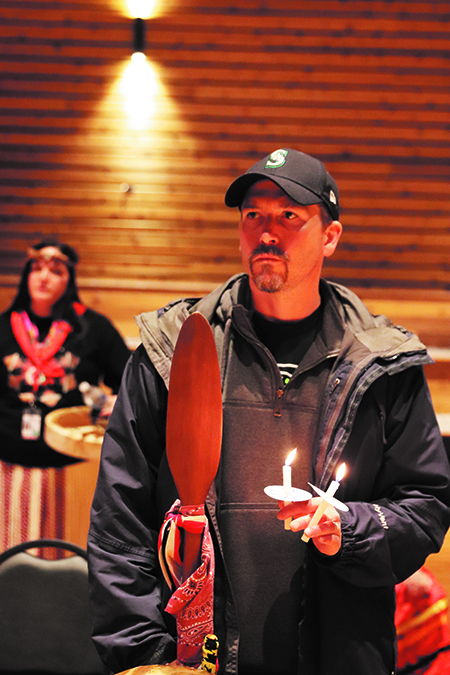
Tribal member and QCT teacher, Margie Santibanez shared, “I came out for the MMIW vigil because I have friends who started out in domestic violence relationships and two of them almost lost their lives to it. Some of my students were murdered, as I worked at the school which is now known as Heritage. My heart has always been heavy. This is my way of being a voice for them, helping the families heal if I can by doing the prayers and teaching the kids what it is to be respectable to each other. That’s my goal, that’s why I came.”
As the candles were lit, the people held an extended moment of silence for the survivors and those we lost due to the epidemic. Tears were shed, hugs were shared, and prayers and songs were offered as the community gathered with heavy hearts on National MMIWP Awareness Day and took an important step towards healing.
Showcasing the wide-range of artistic skills among our Native American students
By Micheal Rios, Tulalip News
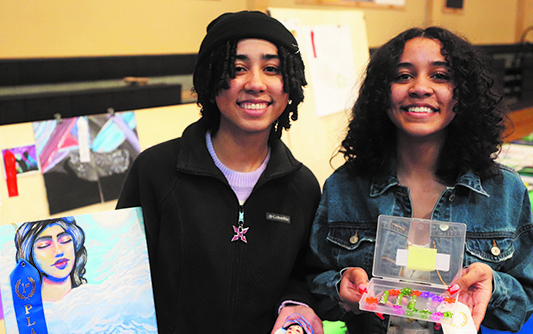
Creative inclined Native American students of the Marysville School District sauntered through a makeshift art gala that was the Don Hatch Youth Center on Thursday May 5 and Friday May 6 for the 2022 Art Fest. Accompanied by their families, friends and teachers, the emerging artists ranging from 1st to 12th grade wowed Art Fest patrons and judges with a variety of imaginative works that centered around a communal Tulalip experience.
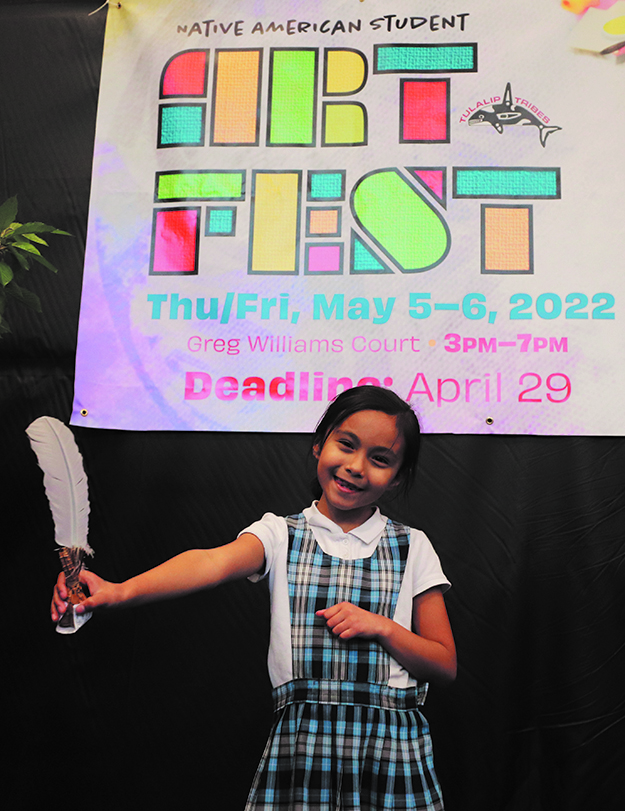
“Our annual Art Fest is an opportunity for each Native student within the District to express themselves in a creative way. We increased the event this year, going from one day to two days, to provide a more family friendly environment that was both safe and welcoming,” explained event coordinator, Deyamonta Diaz. “All the work that goes on behind the scenes to make this event possible, it’s like an all-hands-on-deck effort, is so worth it for our community to witness the pride and joy every student puts into their art. The end result surpassed all our expectations because we got over 900 total submissions. That’s more than double what we’ve averaged the last couple years.”
For more than two decades now, Marysville School District has partnered with the Tulalip Tribes to dedicate an evening to the art scene embraced by emerging Tulalip artists and other Native students within the District. The Art Fest gives fledgling creatives an opportunity to show off their awe-inspiring talents to the community, while also getting a chance to take home a coveted 1st place blue ribbon and all the bragging rights that come with it.
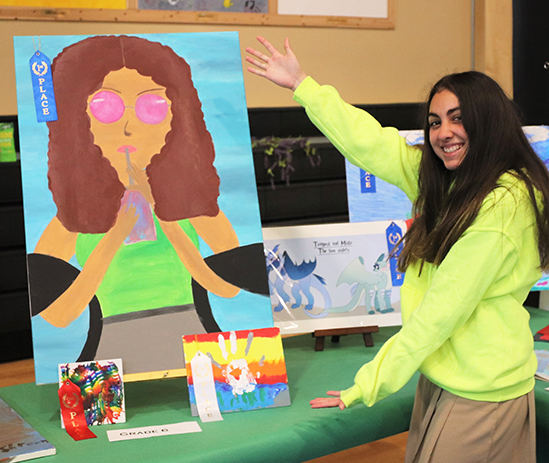
Such was the case with Northwest Academy 1st grader Ellie Fryberg. She radiated pure joy while leading her family and multiple peers to her 1st place winning drawing of a rose. Delicately drawn in colored pencils and shaded with red and green, Ellie took one picture after another with her adoring fans in front of her framed art piece. She shared roses are her favorite flowers because rose is her middle name. “It took me a day to draw it at school. My teacher helped me a little bit. I draw roses all the time on the weekends,” shared the very happy 7-year-old.
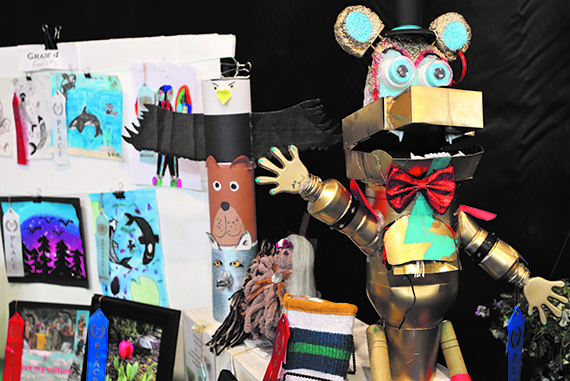
Ellie and her fellow student culture bearers were able to win 1st, 2nd or 3rd place, plus honorable mention, in a variety of artistic mediums. Categories included culture, drawing, painting, writing, mixed media, sculpture, digital art, and pure heart. The top four from each grade and category received a ceremonial ribbon recognizing their talents and a monetary prize.
“It was amazing to see just how talented our Native students are. The new ideas and concepts they come up with every year continue to surprise us judges,” shared Native Advocate Doug Salinas while admiring the middle school painting section. “I think every kid has the capability to be an artist because their imagination has no limits.”
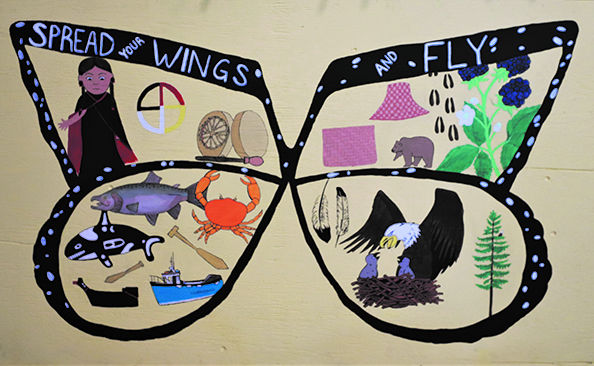
This year’s Native Art Fest received over 900 submissions, with the most popular category by far being painting. There were many young artists who showed off their diverse talents by submitting artwork in as many categories as they could. Eleventh grader Samara Davis and sixthgrader Cora Jimicum were two such powerhouses that claimed top honors in multiple categories.
“I like creating art because it’s fun,” said Cora while pointing out all her art pieces that earned ribbons. “Creative writing is my favorite art category because I can create all kinds of characters and have them go through one adventure after another. They can grow and change and just be happy.”
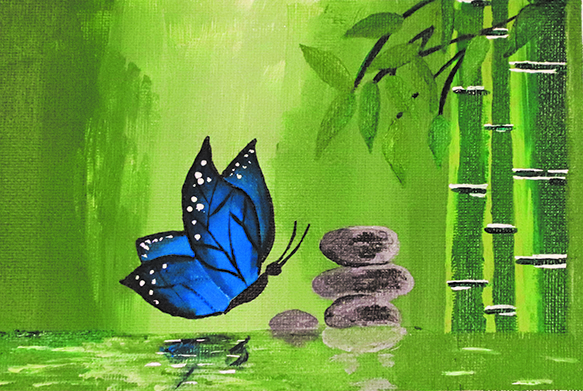
Meanwhile, Art Fest veteran Samara has wowed event attendees for years with her established creative talents. She routinely collects a handful of blue ribbons for entering one-of-a-kind art in as many categories as she can. She admitted to challenging herself more this year by trying mediums she hadn’t in the past, like sculpting and delving into mixed media. For her efforts she was once again rewarded with a number of 1st place ribbons and a stack of prize money. Her little sister, Abigail, has been biding her time, watching and learning from her big sister, to develop her own creative style.
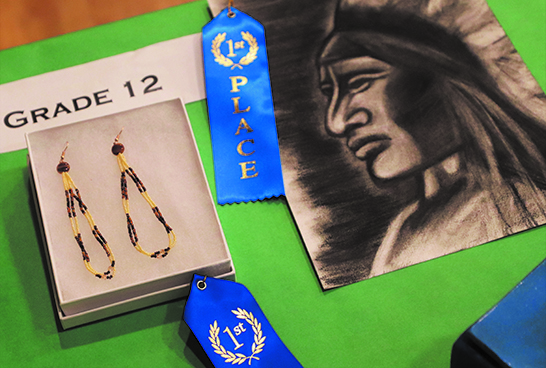
“Growing up and watching my sister and brother both create all kinds of art for this festival, it has made me a better artist because I do try to compete with them, sometimes,” shared 14-year-old Abigail who was most proud of her mixed media ceramic nail set she won 2nd place for. “For me, art is all about expressing yourself and having a creative outlet to process whatever you are going through emotionally. I recommend all students, not just the Native American ones, take art classes because you never know which medium or category you may be super talented at and develop a real passion for.”
Interwoven through the thought-provoking pieces were not so subtle tie-ins to ongoing equality awareness campaigns, human rights issues and demands for social justice. There was a definite spotlight on the Missing and Murdered Indigenous Women’s crisis, declarations of the Native-inspired rally cry Water Is Life, and a poem by a young boy that pulled at the heart strings as he detailed his experience of growing up without a dad.
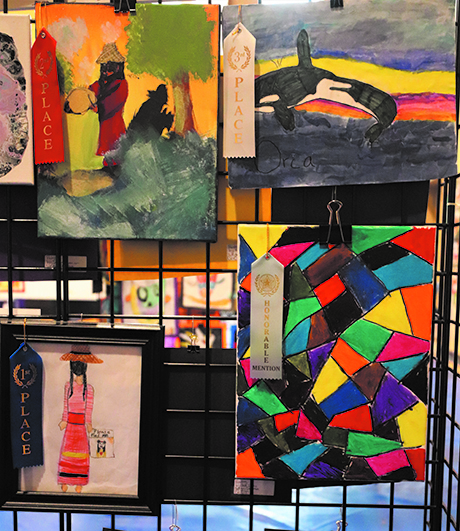
The message being sent loud and clear is that yes, in fact, the youngest among us are paying attention to current events and culture related protests. More importantly, they are capable of channeling their inner turmoil and personal experiences into unique art products.
“When our kids create artwork for this event they are able to mix in elements of their personality, culture, family values, and what matters to them as individuals. It’s really incredible to see how even when there are twenty entries of the same type, each is different and unique in its own way because they reflect the artist who created it,” said Courtney Jefferson, Positive Youth Development manager.
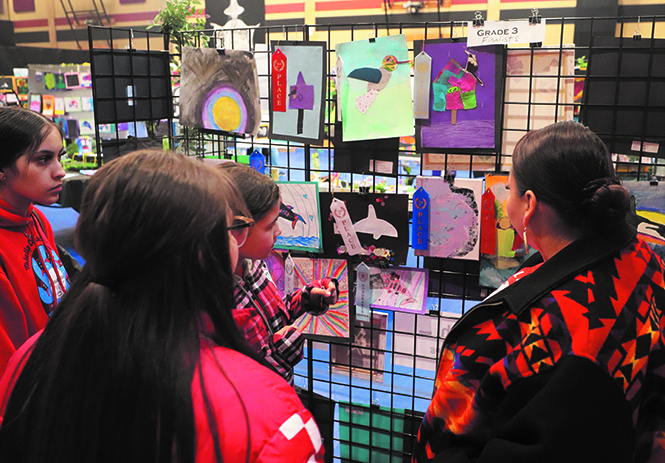
“Witnessing our kids get inspired from cultural pillars like Billy Frank Jr. is nice to see because that means they are learning about these foundational figures in school and retaining the information,” she added. “This proves how powerful it is to educate our people about our shared culture. Especially for the elementary aged children it’s so important they learn about the legacy of those who came before us and made it possible for us to thrive today.”
Overall, this year’s two-day Art Fest showcased the wide-range of artistic skills among our Native American students, while once again confirming the limitless imagination of authentic Native art brought created by the next generation.
Matthew War Bonnet shares boarding school experience
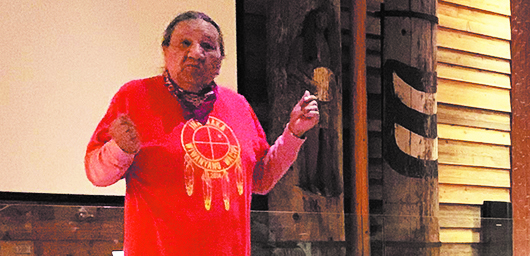
By Shaelyn Hood, Tulalip News
Decades after the catastrophic existence of residential boarding schools, tribal communities continue to mourn and feel the trauma from their elders’ past. There are few remaining tribal elders who lived through this period, and even fewer who feel comfortable enough to tell their stories. Matthew War Bonnet (Lakota) is one elder who has been on the frontlines at community events, sharing his eight-year experience of being in a boarding school, and demanding apologies from the churches involved.
On Saturday, April 30, Tulalip community members gathered at the Hibulb Cultural Center to hear Matthew tell his story.
Matthew shared that he was around 11 years old when he was first taken from his home and forced into a boarding school in Michigan. These schools were meant to hold Native children up through the 12th grade, force European colonization, and deplete all tribal culture. He spoke of going away nine months at a time, living far from his family, to schools where he could no longer speak his language, no longer sing or drum, or carry out any actions that reflected his culture. Now required to follow a new religion, and partake in confessionals, he was often threatened if he didn’t have anything to repent for.
The amount of abuse that he and his classmates endured was astronomical and dehumanizing. He remembered being stripped of their clothes at a moment’s notice, being slashed with razor straps and struck with cattle-like prods. And often, his classmate’s ears were cut off.
Not long after his departure from the school, Matthew talked about seeing the toll that it was taking on the survivors. Years of torture led to lifelong scars not only on their bodies, but on their memories and hearts as well. Matthew shared how the people that survived boarding schools never truly walked away from it all. He spoke of the all-consuming anger that the survivors felt, never feeling any sense of peace. Many turned to drugs and alcohol and sometimes suicide to cope with the torment of their past. Some would even take their anger out on their families and children.
But, sympathizing with what they have been through, Matthew said, “it’s not fair to blame them, with not understanding what they’ve been through. What can you say that will actually help take away their anger?”
Many people in the Tulalip community speak of generational trauma. It is the concept that a shared communal trauma can be passed down from one generation to the next. This can ultimately can lead to generations of mistrust, sensitive fight or flight responses, depression, low self-esteem, and more. Generational trauma can quickly take over a community, and devour people’s abilities to heal.
When asked if he has spoken to other survivors in the area, and what similarities they might have with him, Matthew explained, “I never want to speak for anyone else’s experience. All I can do is make myself available to people, and tell my own story.”
Matthew’s son spoke about how he didn’t quite understand what his father had gone through, “as a kid growing up, I noticed my aunts and uncles didn’t trust my teachers at our school, and white people in general. For a long time, I didn’t understand it. But they (the survivors) were truly broken as children. I look at my son today and can’t imagine not being in control and being able to protect him.”
With the recent discoveries of Indigenous remains from the works of boarding schools, tribal communities are coming together and finding strength in conversation. As well as that, the voices of our people have begun to force the churches’ recognition for their doings.
“The church needs to acknowledge what they’ve done. These survivors of mission schools are suffering every day, and apologies don’t cut it. They should be making attempts to make things right, and help find the bodies of our people”, Matthew said.
It is the duty of our people to protect our elders, and create a better future for the generations after us. The more discussions had around residential boarding schools will only further heal tribal communities. Uniting together, and creating a safe shared space for Native Americans to discuss our dark past, and ultimately how we can move forward together. Generational trauma can stop with us.
May 7, 2022 syəcəb
Please use the following link to download the May 7, 2022 issue of the syəcəb